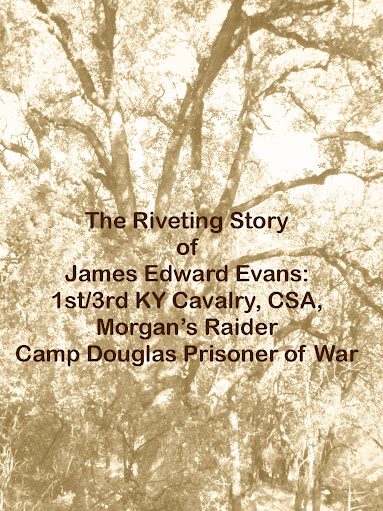 Notes from which the February 13, 1863 Roll at McMinnville, Tennessee was compiled. James Edward Evans appears near the bottom of page 78. Clicking on the image will enlarge it.
Notes from which the February 13, 1863 Roll at McMinnville, Tennessee was compiled. James Edward Evans appears near the bottom of page 78. Clicking on the image will enlarge it.February 13, 1863
On Monday, February 13, 1863, roll was taken at McMinnville, Tennessee. The bottom of the roll reads:
“In September, 1862, the company (then known as Company “G,” Forrest’s Regiment) had been captured at Fort Donelson, together with horses, equipment, etc., and was exchanged at Vicksburg, Miss.; proceeded thence to Knoxville, Tenn., and were ordered to report to General John H. Morgan, at Murfreesboro, Tenn.: acted accordingly and were assigned to Gano’s Regiment of Morgan’s Cavalry. Since being connected with that command, the company has accompanied it into Kentucky and returned with loss of four men, as reported on the rolls. NOTE – Previous to the surrender at Fort Donelson this company was serving as Company “G,” Forrest’s 3rd Tennessee Cavalry.”
ROLL OF COMPANY I, SEVENTH REGIMENT CAVALRY, KENTUCKY VOLUNTEERS, CONFEDERATE STATES ARMY, #31 Evans, James, Rank : Private, When Enlisted: Sept. 7, 1862, Where Enlisted: Danville, Ky”[i]
What was this? The Compiled Military Service Record for James Edward Evans always lists him with the 3rd. How the 3rd came to be redesignated at the 7th is explained below.
“THIRD REGIMENT CAVALRY, KENTUCKY VOLUNTEERS, CONFEDERATE STATES ARMY. ROSTER FIELD AND STAFF, THIRD REGIMENT CAVALRY, KENTUCKY VOLUNTEERS, CONFERATE STATES ARMY
1. J. Russell Butler, Colonel
2. Jack Allen, Lieut. Colonel
3. Jacob w. Griffith, Lieut. Colonel
4. J. T. Chenoweth, Major
NOTE ~ For Roster and Rolls of Gano’s 3rd Regiment, see Roster and Rolls of the 7th Kentucky Regiment Cavalry, C.S.A. Gano’s Regiment was part of 1st Brigade (Duke’s) Morgan’s Division and was known as the 3rd Regiment throughout the war – Richard Gano, Colonel; E. L. Hoffman, Lieut. Colonel – but it seems there was some one who was operating in Southwestern Kentucky and Tennessee who had a Commission as Colonel of the 3rd Kentucky Cavalry, C. S. A, ate-dating Colonel Gano’s; so the U S. War Office (Dept. Records of the Rebellion) changed Gano’s Third Regiment to the 7th Regiment Kentucky Cavalry.” [ii]
Studying the Company rolls listed within McDowell’s The Report of the Adjutant General of the State of Kentucky, Civil War, Confederate, Vol. I, one can find clues as to the many reorganizations that took place as the Army of Tennessee was formed. On the Roll of Company F, 7th Regiment Kentucky Volunteers, C. S. A., twenty eight names are noted as “Member Company ‘E’ 3rd KY Cavalry; attached.”[iii] Six former members of Company I, 1st Regiment Cavalry (Edward Brown, W. Dickerson, James Evans, John Gray, R. H. Harmon, and S. O’Bannon) became members of Company I, 7th Regiment Cavalry.[iv] Thus, while designations continuously changed, James appears to have spent his entire time in the Cavalry with at least five constant comrades.
There remains a final consideration which may explain why James referred to himself as a member of the 3rd KY. Southerners who became prisoners of war, especially if they had become associated with Partisan Ranger Groups, often gave their initial enlistment rank, the name of their Company, and the name of the Regiment in which they had first enrolled in the hope they would face quicker exchange and better treatment while “guests of the North.” In 1862, U. S. Secretary of War Edwin M. Stanton had excluded prisoners classified as guerrillas from exchange under the conditions of the Dix-Hill Cartel. Thus, those associated with John Hunt Morgan’s raids had good reason to present “other information.”
February 14, 1862
“February 14, 1862, Fort Donelson, Tennessee
Have been much exercised in mind for several days about the increase of card playing cannot expect to stop the men while officers openly play daily I pray for wisdom & grace Oh my Father teach what I ought to do & give me the strength to do it."
February 20, 1863
“Louisville, KY., February 20, 1863
Col. A. Stager:
Rebels in Considerable force at Somerset, Ky., supposed to be under Morgan, advancing into interior of Kentucky. General Rosecrans is preparing to change base to Tennessee."
February 21, 1863
“Saturday, February 21
.
Started again. Went about two miles, then started out foraging. Took five loads of corn and four of hay. Went on. Overtook regt. Camped near Crab Orchard. Took three of Morgan's pickets. Morgan reported at Somerset or Mt. Vernon.”
~Charles W. Durling, Company G, 45th Ohio Infantry [viii]
February 23, 1863
“Louisville, Ky., Feb. 23, 1863
Started again. Went about two miles, then started out foraging. Took five loads of corn and four of hay. Went on. Overtook regt. Camped near Crab Orchard. Took three of Morgan's pickets. Morgan reported at Somerset or Mt. Vernon.”
~Charles W. Durling, Company G, 45th Ohio Infantry [viii]
February 23, 1863
“Louisville, Ky., Feb. 23, 1863
I have no news to tell you except that we discovered last week a soldier who turned out to be a girl. She had already been in service for 21 months and was twice wounded. Maybe she would have remained undiscovered for a long time, if she hadn't fainted. She was given a warm bath which gave the secret away."
February 26, 1863
“Thursday, February 26
Started again. Four wagons burned, not being able to take them. Considerable camp equipage thrown away also. Reach Ky. River, build a raft. Cannot use it, the current of river being too strong. Let it go down stream and go to next ferry. Take part of things to opposite shore. Morgan reported within four rules of here. Get supper at private house near here, our rations having given out.”
~ Charles W. Durling, Company G, 45th Ohio Infantry [x]
February 28, 1863
On a roll taken this date, James Edward Evans appeared as absent without leave since 18 November 1862 from Capt. H. C. Myer’s Co., Butler’s Regiment, Kentucky Cavalry. This information conflicts the information found on the February 13th McMinnville Roll.
How could this be?
Confederate records are woefully scant. Due to a lack of man power, some records were never filed. Other records were lost to fires or destroyed in battle. Some records were compiled from notes and/or best memory. These compilations were sometimes written by men who were not part of the company or were not present when the notes regarding the event were taken.
As the month drew to an end, the infernal reorganizing continued. A note at the bottom of one of James Service Cards reads:
“This company was also known as Company I and the regiment was also known as the 3rd Regiment Kentucky Cavalry which was formed about November, 1862 by the consolidation of three regiments which were commanded by Colonels D. Howard Smith, J. Warren Grigsby, and J. R. Butler. It was consolidated in March, 1863, with the 1st (Helm’s) Regiment Kentucky Cavalry and formed the 1st (Butler’s) Regiment Kentucky Cavalry. This company appears to have become (Old) Company H of the new regiment.” [xi]
ENDNOTES
[i] McDowell, “The Report of the Adjutant General of the State of Kentucky, Civil War, Confederate”, Vol. I pgs 710 -713.
[ii] McDowell, “The Report of the Adjutant General of the State of Kentucky, Civil War, Confederate”, Vol. I pgs 594 – 595.
[iii] McDowell, “The Report of the Adjutant General of the State of Kentucky, Civil War, Confederate”, Vol. I pgs 700 -705.
[iv] McDowell, “The Report of the Adjutant General of the State of Kentucky, Civil War, Confederate”, Vol. I pgs 528 -529 and 710 -713.
[v] Levy, George. “To Die in Chicago, Confederate Prisoners at Camp Douglas 1862-65,” 1999, Chap. 8, p. 131.
[vi] Cogshall, Israel. "Journal of Israel Cogshall, 1862-1863," ed. Cecil K. Byrd, Indiana Magazine of History 42, no. 1 ,March 1946, p. 74.
[vii] “Official Records of the Union and Confederate Armies Vol. XXIII, Part – II Correspondence” p.33.
[viii] Diary of Charles W. Durling.
[ix] Shelly, Joseph Frederick. "The Shelly Papers," ed. Fanny Anderson and trans. Sophie Gemant, Indiana Magazine of History 44, no. 2 ,June 1948, p. 186.
[x] Diary of Charles W. Durling.
[xi] Compiled Military Service Record for James Edward Evans.





No comments:
Post a Comment